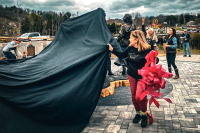Cherokee art institute gets new home
Several years ago, an idea was planted to establish an institution of higher education on the Qualla Boundary that would emphasize and preserve the rich artistic traditions of the Eastern Band of Cherokee Indians. Out of that dream, the Oconaluftee Institute of Cultural Arts took root — and today, the program is thriving.
The OICA was created out of a desire to establish a community college on the reservation and is only the second higher education institution in the country to offer a two-year degree in Native American arts.
The program celebrated its move into a new location in Cherokee last week. With its 5,600 square feet, studio spaces, a gallery space and a classroom to house its 10 students, the new home of the OICA is testament to how far the program has come.
The arts college was established in 2007 through a partnership with Southwestern Community College and Western Carolina University. It started out with two students in a space barely big enough to turn around. But while the program had humble beginnings, it was built around a lofty and unique vision.
“A lot of art has been focused out West, and a lot of people’s impression of Native American art is Southwestern art,” says Luzenne Hill, marketing director for the OICA. “But every tribe interprets their art in a different way.”
Specifically, the program aimed to showcase the artistic traditions of tribes east of the Mississippi River. Craftmaking, initially born out of necessity, has been passed down through generations by native tribes like the Eastern Band. Skills like basketweaving, woodcarving and pottery are so intertwined with native culture that many tribal members simply see them as a way of life.
Related Items
“For decades, our people have been crafters, but haven’t always looked at their crafts as art,” said Juanita Wilson, chair of the OICA board.
The OICA teaches traditional art forms like basketweaving with native materials, pottery, and wood carving. But students also receive education in a variety of non-traditional art forms.
“We insisted that we keep tradition at the heart of it, but also wanted to go beyond that,” Wilson said.
Students learn traditional arts and crafts, but are also instructed on foundations of art education like western art history, drawing, and painting. Hill said the goal is to enhance the students’ art experience as much as possible, so that whatever speaks to them can also become a way of expressing their work.
“What we want to do is open people up and say, these are possibilities,” Hill said.
Henrietta Heeter, the first graduate of the program, knows perhaps better than anyone of the possibilities the program helps students to see. The OICA enticed Heeter to pursue her first higher education degree at the age of 50.
What finally convinced Heeter to return to school was, “the thought of our people having our own art institute, because there are amazing artists here,” she says.
Heeter says she’s enjoyed it all — from pottery, to carving, to weaving on a loom with native rivercane and white oak. Her true passion lies in painting, which she did at the OICA with pastels, charcoal, watercolors, and other materials.
“It opened me up to other possibilities with what I can do with my art,” Heeter says. “Hopefully I can now make a living off of it.”
Through the program, which directly transfers to a fine arts degree program at Western Carolina University, Heeter will go on to pursue an undergraduate degree.
The tribe, in conjunction with SCC and WCU, hopes to expand the OICA to attract students from all over the Southeast and Midwest, eventually increasing the program’s enrollment to 25 or 30 students.
Program leaders ultimately hope to locate the OICA in a permanent home in the old Cherokee High School.









